Searching for Natural Conductive Fibrous Structures via a Green Sustainable Approach Based on Jute Fibers and Silver Nanoparticles
Abstract
:1. Introduction
2. Materials and Methods
2.1. Materials
2.2. Sample Preparation
2.2.1. Pretreatment of Jute Fabric with Plasma
2.2.2. In Situ Synthesis of Silver Nanoparticles onto Jute
2.2.3. Synthesis of Ag-PEG Nanoparticles and Deposition onto Jute
2.3. UV–Visible Absorption Spectra
2.4. Ground State Diffuse Reflectance and CIELAB Color Coordinates
2.5. Attenuated Total Reflectance-Fourier Transform Infrared Spectroscopy (ATR-FTIR)
2.6. Field Emission Scanning Electron Microscopy (FESEM) and Energy Dispersive X-ray (EDX)
2.7. Resistivity Measurements Using the Two-Point Probe Method
3. Results and Discussion
3.1. Jute Fabric Pretreatment
3.2. In Situ Jute Functionalization by the UV Photoreduction Process and Resistivity Values
3.3. Jute with Ag-PEG NPs and Resistivity Values
3.4. Characterization of Silver Nanoparticles Produced with PEG
3.4.1. UV–Visible Spectroscopy
3.4.2. Scanning Transmission Electron Microscopy (STEM)
3.4.3. Ground State Diffuse Reflectance
3.5. Characterization of the Silver Nanoparticles Synthesized In Situ onto Jute Fabric
3.6. ATR-FTIR Characterization
4. Conclusions
Acknowledgments
Author Contributions
Conflicts of Interest
References
- Cui, H.-W.; Suganuma, K.; Uchida, H. Highly stretchable, electrically conductive textiles fabricated from silver nanowires and cupro fabrics using a simple dipping-drying method. Nano Res. 2015, 8, 1604–1614. [Google Scholar] [CrossRef]
- Miao, M.; Xin, J.H. Engineering of High-Performance Textiles; Woodhead Publishing Ltd.: Cambridge, UK, 2018; pp. 305–334. ISBN 978-0-08-101273-4. [Google Scholar]
- Guo, L.; Bashir, T.; Bresky, E.; Persson, N.-K. Electroconductive textiles and textile-based electromechanical sensors—Integration in as an approach for smart textiles. In Smart Textiles and Their Applications; Koncar, V., Ed.; Woodhead Publishing Series in Textiles; Woodhead Publishing: Oxford, UK, 2016; pp. 657–693. ISBN 978-0-08-100574-3. [Google Scholar]
- Kim, Y.K.; Wang, H.; Mahmud, M.S. Wearable body sensor network for health care applications. In Smart Textiles and Their Applications; Koncar, V., Ed.; Woodhead Publishing Series in Textiles; Woodhead Publishing: Oxford, UK, 2016; pp. 161–184. ISBN 978-0-08-100574-3. [Google Scholar]
- Stoppa, M.; Chiolerio, A. Wearable Electronics and Smart Textiles: A Critical Review. Sensors 2014, 14, 11957–11992. [Google Scholar] [CrossRef] [PubMed]
- Yang, T.; Xie, D.; Li, Z.; Zhu, H. Recent advances in wearable tactile sensors: Materials, sensing mechanisms, and device performance. Mater. Sci. Eng. R Rep. 2017, 115, 1–37. [Google Scholar] [CrossRef]
- Fangueiro, R.; Rana, S. Natural Fibres: Advances in Science and Technology towards Industrial Applications; Springer: Dordrecht, The Netherlands, 2016; ISBN 978-94-017-7513-7. [Google Scholar]
- Fangueiro, R.; Rana, S. Advances in Natural Fibre Composites: Raw Materials, Processing and Analysis, 1st ed.; Springer International: Cham, Switzerland, 2018; ISBN 978-3-319-64640-4. [Google Scholar]
- Gopinath, A.; Kumar, M.S.; Elayaperumal, A. Experimental Investigations on Mechanical Properties of Jute Fiber Reinforced Composites with Polyester and Epoxy Resin Matrices. Procedia Eng. 2014, 97, 2052–2063. [Google Scholar] [CrossRef]
- Das, S. Mechanical properties of waste paper/jute fabric reinforced polyester resin matrix hybrid composites. Carbohydr. Polym. 2017, 172, 60–67. [Google Scholar] [CrossRef] [PubMed]
- Ramana, M.V.; Ramprasad, S. Experimental Investigation on Jute/Carbon Fibre reinforced Epoxy based Hybrid Composites. Mater. Today Proc. 2017, 4, 8654–8664. [Google Scholar] [CrossRef]
- Arfaoui, M.A.; Dolez, P.I.; Dubé, M.; David, É. Development and characterization of a hydrophobic treatment for jute fibres based on zinc oxide nanoparticles and a fatty acid. Appl. Surf. Sci. 2017, 397, 19–29. [Google Scholar] [CrossRef]
- Sahu, U.K.; Mahapatra, S.S.; Patel, R.K. Synthesis and characterization of an eco-friendly composite of jute fiber and Fe2O3 nanoparticles and its application as an adsorbent for removal of As(V) from water. J. Mol. Liq. 2017, 237, 313–321. [Google Scholar] [CrossRef]
- Atwa, Y.; Maheshwari, N.; Goldthorpe, I.A. Silver nanowire coated threads for electrically conductive textiles. J. Mater. Chem. C 2015, 3, 3908–3912. [Google Scholar] [CrossRef]
- Dong, B.H.; Hinestroza, J.P. Metal Nanoparticles on Natural Cellulose Fibers: Electrostatic Assembly and In Situ Synthesis. ACS Appl. Mater. Interfaces 2009, 1, 797–803. [Google Scholar] [CrossRef] [PubMed]
- Kim, Y.; Zhu, J.; Yeom, B.; Di Prima, M.; Su, X.; Kim, J.-G.; Yoo, S.J.; Uher, C.; Kotov, N.A. Stretchable nanoparticle conductors with self-organized conductive pathways. Nature 2013, 500, 59–63. [Google Scholar] [CrossRef] [PubMed]
- Popa, M.; Pradell, T.; Crespo, D.; Calderón-Moreno, J.M. Stable silver colloidal dispersions using short chain polyethylene glycol. Colloids Surf. A 2007, 303, 184–190. [Google Scholar] [CrossRef]
- Qiu, L.; Pol, V.G.; Calderon-Moreno, J.; Gedanken, A. Synthesis of tin nanorods via a sonochemical method combined with a polyol process. Ultrason. Sonochem. 2005, 12, 243–247. [Google Scholar] [CrossRef] [PubMed]
- Müller, H.; Opitz, C.; Skala, L. The highly dispersed metal state—Physical and chemical properties. J. Mol. Catal. 1989, 54, 389–405. [Google Scholar] [CrossRef]
- Rehan, M.; Barhoum, A.; Van Assche, G.; Dufresne, A.; Gätjen, L.; Wilken, R. Towards multifunctional cellulosic fabric: UV photo-reduction and in-situ synthesis of silver nanoparticles into cellulose fabrics. Int. J. Biol. Macromol. 2017, 98, 877–886. [Google Scholar] [CrossRef] [PubMed]
- Ouadil, B.; Cherkaoui, O.; Safi, M.; Zahouily, M. Surface modification of knit polyester fabric for mechanical, electrical and UV protection properties by coating with graphene oxide, graphene and graphene/silver nanocomposites. Appl. Surf. Sci. 2017, 414, 292–302. [Google Scholar] [CrossRef]
- Khalil, A.M.; Hassan, M.L.; Ward, A.A. Novel nanofibrillated cellulose/polyvinylpyrrolidone/silver nanoparticles films with electrical conductivity properties. Carbohydr. Polym. 2017, 157, 503–511. [Google Scholar] [CrossRef] [PubMed]
- Stiufiuc, R.; Iacovita, C.; Lucaciu, C.M.; Stiufiuc, G.; Dutu, A.G.; Braescu, C.; Leopold, N. SERS-active silver colloids prepared by reduction of silver nitrate with short-chain polyethylene glycol. Nanoscale Res. Lett. 2013, 8, 47. [Google Scholar] [CrossRef] [PubMed]
- Pacioni, N.L.; Borsarelli, C.D.; Rey, V.; Veglia, A.V. Synthetic Routes for the Preparation of Silver Nanoparticles. In Silver Nanoparticle Applications: In the Fabrication and Design of Medical and Biosensing Devices; Alarcon, E.I., Griffith, M., Udekwu, K.I., Eds.; Springer International Publishing: Cham, The Netherlands, 2015; pp. 13–46. ISBN 978-3-319-11262-6. [Google Scholar]
- Iravani, S.; Korbekandi, H.; Mirmohammadi, S.V.; Zolfaghari, B. Synthesis of silver nanoparticles: Chemical, physical and biological methods. Res. Pharm. Sci. 2014, 9, 385–406. [Google Scholar] [PubMed]
- Luo, C.C.; Zhang, Y.H.; Wang, Y.G. Palladium nanoparticles in poly(ethyleneglycol): The efficient and recyclable catalyst for Heck reaction. J. Mol. Catal. A 2005, 229. [Google Scholar] [CrossRef]
- Nam, S.; Parikh, D.V.; Condon, B.D.; Zhao, Q.; Yoshioka-Tarver, M. Importance of poly(ethylene glycol) conformation for the synthesis of silver nanoparticles in aqueous solution. J. Nanopart. Res. 2011, 13, 3755–3764. [Google Scholar] [CrossRef]
- Lakshmanan, A.; Chakraborty, S. Coating of silver nanoparticles on jute fibre by in situ synthesis. Cellulose 2017, 24, 1563–1577. [Google Scholar] [CrossRef]
- Cao, X.; Ding, B.; Yu, J.; Al-Deyab, S.S. In situ growth of silver nanoparticles on TEMPO-oxidized jute fibers by microwave heating. Carbohydr. Polym. 2013, 92, 571–576. [Google Scholar] [CrossRef] [PubMed]
- Omrani, A.A.; Taghavinia, N. Photo-induced growth of silver nanoparticles using UV sensitivity of cellulose fibers. Appl. Surf. Sci. 2012, 258, 2373–2377. [Google Scholar] [CrossRef]
- Zille, A.; Oliveira, F.R.; Souto, A.P. Plasma Treatment in Textile Industry. Plasma Process. Polym. 2015, 12, 98–131. [Google Scholar] [CrossRef] [Green Version]
- Tuominen, M.; Lahti, J.; Lavonen, J.; Penttinen, T.; Räsänen, J.P.; Kuusipalo, J. The Influence of Flame, Corona and Atmospheric Plasma Treatments on Surface Properties and Digital Print Quality of Extrusion Coated Paper. J. Adhes. Sci. Technol. 2010, 24, 471–492. [Google Scholar] [CrossRef]
- Montazer, M.; Alimohammadi, F.; Shamei, A.; Rahimi, M.K. In situ synthesis of nano silver on cotton using Tollens’ reagent. Carbohydr. Polym. 2012, 87, 1706–1712. [Google Scholar] [CrossRef]
- Gibeop, N.; Lee, D.W.; Prasad, C.V.; Toru, F.; Kim, B.S.; Song, J. Il Effect of plasma treatment on mechanical properties of jute fiber/poly(lactic acid) biodegradable composites. Adv. Compos. Mater. 2013, 22, 389–399. [Google Scholar] [CrossRef]
- Bozaci, E.; Sever, K.; Demir, A.; Seki, Y.; Sarikanat, M.; Ozdogan, E. Effect of the atmospheric plasma treatment parameters on surface and mechanical properties of jute fabric. Fibers Polym. 2009, 10, 781–786. [Google Scholar] [CrossRef]
- Huh, Y.I.; Bismark, M.; Kim, S.; Lee, H.K.; Nah, C. Effects of Plasma Treatment on Mechanical Properties of Jute Fibers and Their Composites with Polypropylene. Elastomers Compos. 2012, 47, 310–317. [Google Scholar] [CrossRef]
- Żenkiewicz, M.; Richert, J.; Rytlewski, P.; Moraczewski, K. Some Effects of Corona Plasma Treatment of Polylactide/Montmorillonite Nanocomposite Films. Plasma Process. Polym. 2009, 6, S387–S391. [Google Scholar] [CrossRef]
- Praskalo-Milanovic, J.Z.; Kostic, M.M.; Dimitrijevic-Brankovic, S.I.; Skundric, P.D. Silver-loaded lyocell fibers modified by tempo-mediated oxidation. J. Appl. Polym. Sci. 2010, 117, 1772–1779. [Google Scholar] [CrossRef]
- De Farias, J.G.G.; Cavalcante, R.C.; Canabarro, B.R.; Viana, H.M.; Scholz, S.; Simão, R.A. Surface lignin removal on coir fibers by plasma treatment for improved adhesion in thermoplastic starch composites. Carbohydr. Polym. 2017, 165, 429–436. [Google Scholar] [CrossRef] [PubMed]
- Khoathane, M.C.; Sadiku, E.R.; Agwuncha, C.S. Surface Modification of Natural Fiber Composites and their Potential Applications. In Surface Modification of Biopolymers; John Wiley & Sons, Inc.: Hoboken, NJ, USA, 2015; pp. 370–400. ISBN 9781119044901. [Google Scholar]
- Ferreira, D.P.; Conceição, D.S.; Calhelha, R.C.; Sousa, T.; Socoteanu, R.; Ferreira, I.C.F.R.; Vieira Ferreira, L.F. Porphyrin dye into biopolymeric chitosan films for localized photodynamic therapy of cancer. Carbohydr. Polym. 2016, 151, 160–171. [Google Scholar] [CrossRef] [PubMed]
- Fahmy, A.; El-Zomrawy, A.; Saeed, A.M.; Sayed, A.Z.; El-Arab, M.A.E.; Shehata, H.A.; Friedrich, J. One-step synthesis of silver nanoparticles embedded with polyethylene glycol as thin films. J. Adhes. Sci. Technol. 2017, 31, 1422–1440. [Google Scholar] [CrossRef]
- Shameli, K.; Bin Ahmad, M.; Jazayeri, S.D.; Shabanzadeh, P.; Sangpour, P.; Jahangirian, H.; Gharayebi, Y. Investigation of antibacterial properties silver nanoparticles prepared via green method. Chem. Cent. J. 2012, 6, 73. [Google Scholar] [CrossRef] [PubMed]
- Shameli, K.; Bin Ahmad, M.; Jazayeri, S.D.; Sedaghat, S.; Shabanzadeh, P.; Jahangirian, H.; Mahdavi, M.; Abdollahi, Y. Synthesis and Characterization of Polyethylene Glycol Mediated Silver Nanoparticles by the Green Method. Int. J. Mol. Sci. 2012, 13, 6639–6650. [Google Scholar] [CrossRef] [PubMed]
- Luo, C.C.; Zhang, Y.H.; Zeng, X.W.; Zeng, Y.W.; Wang, Y.G. The role of poly(ethylene glycol) in the formation of silver nanoparticles. J. Colloid Interface Sci. 2005, 288. [Google Scholar] [CrossRef] [PubMed]
- Kardarian, K.; Busani, T.; Osório, I.; Domingos, H.; Igreja, R.; Franco, R.; Cortez, J. Sintering of nanoscale silver coated textiles, a new approach to attain conductive fabrics for electromagnetic shielding. Mater. Chem. Phys. 2014, 147, 815–822. [Google Scholar] [CrossRef]
- Stevenson, A.P.Z.; Blanco Bea, D.; Civit, S.; Antoranz Contera, S.; Iglesias Cerveto, A.; Trigueros, S. Three strategies to stabilise nearly monodispersed silver nanoparticles in aqueous solution. Nanoscale Res. Lett. 2012, 7, 151. [Google Scholar] [CrossRef] [PubMed]
- Agnihotri, S.; Mukherji, S.; Mukherji, S. Size-controlled silver nanoparticles synthesized over the range 5–100 nm using the same protocol and their antibacterial efficacy. RSC Adv. 2014, 4, 3974–3983. [Google Scholar] [CrossRef]
- Rout, S.K.; Tripathy, B.C.; Padhi, P.; Kar, B.R.; Mishra, K.G. A green approach to produce silver nano particles coated agro waste fibers for special applications. Surf. Interfaces 2017, 7, 87–98. [Google Scholar] [CrossRef]
- Cao, X.; Ding, B.; Yu, J.; Al-Deyab, S.S. Cellulose nanowhiskers extracted from TEMPO-oxidized jute fibers. Carbohydr. Polym. 2012, 90, 1075–1080. [Google Scholar] [CrossRef] [PubMed]
- Kafi, A.A.; Magniez, K.; Fox, B.L. A surface-property relationship of atmospheric plasma treated jute composites. Compos. Sci. Technol. 2011, 71, 1692–1698. [Google Scholar] [CrossRef]
- Firoz Babu, K.; Dhandapani, P.; Maruthamuthu, S.; Anbu Kulandainathan, M. One pot synthesis of polypyrrole silver nanocomposite on cotton fabrics for multifunctional property. Carbohydr. Polym. 2012, 90, 1557–1563. [Google Scholar] [CrossRef] [PubMed]
- Ali, A.; Nguyen, N.H.A.; Baheti, V.; Ashraf, M.; Militky, J.; Mansoor, T.; Noman, M.T.; Ahmad, S. Electrical conductivity and physiological comfort of silver coated cotton fabrics. J. Text. Inst. 2017, 1–9. [Google Scholar] [CrossRef]

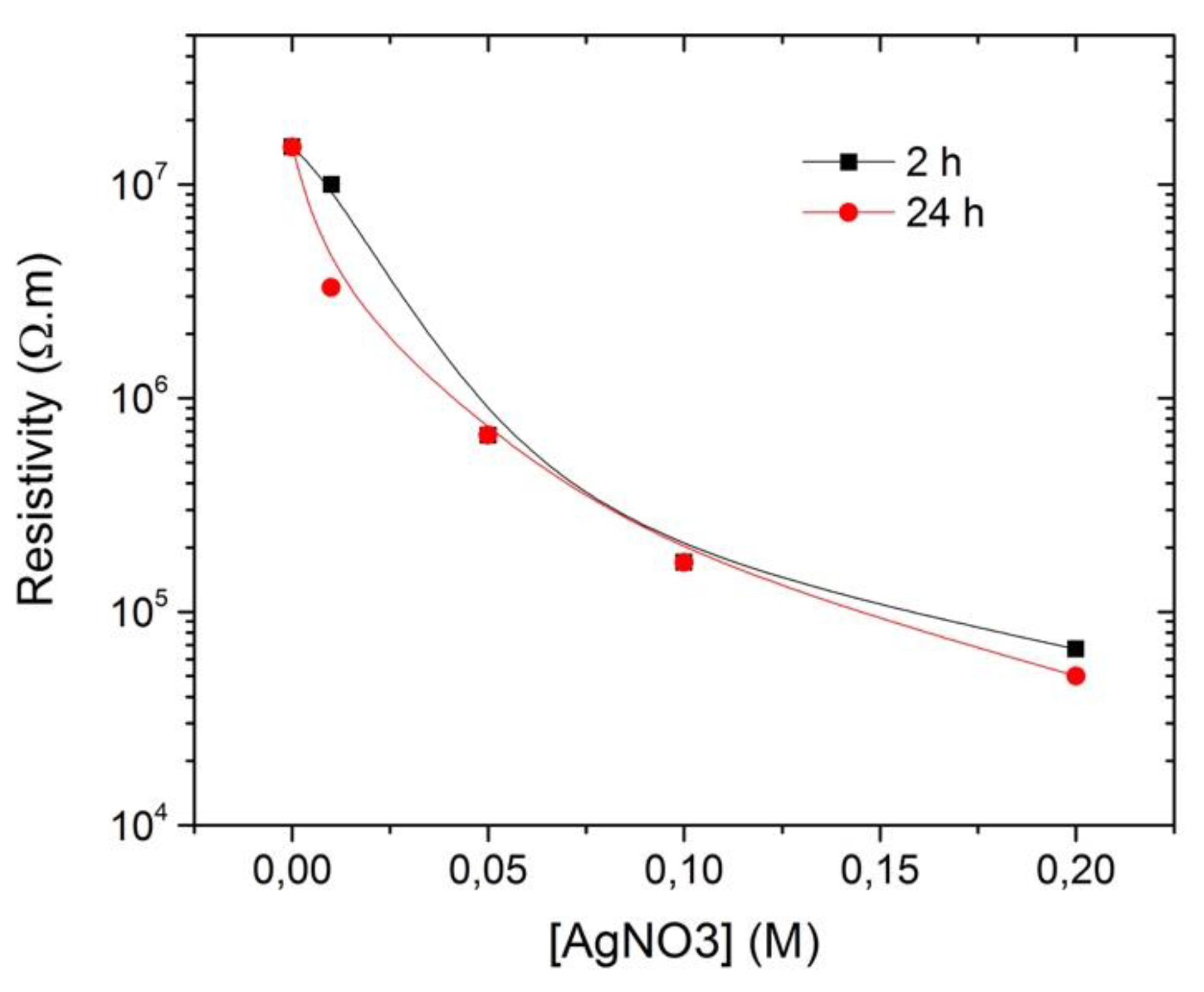
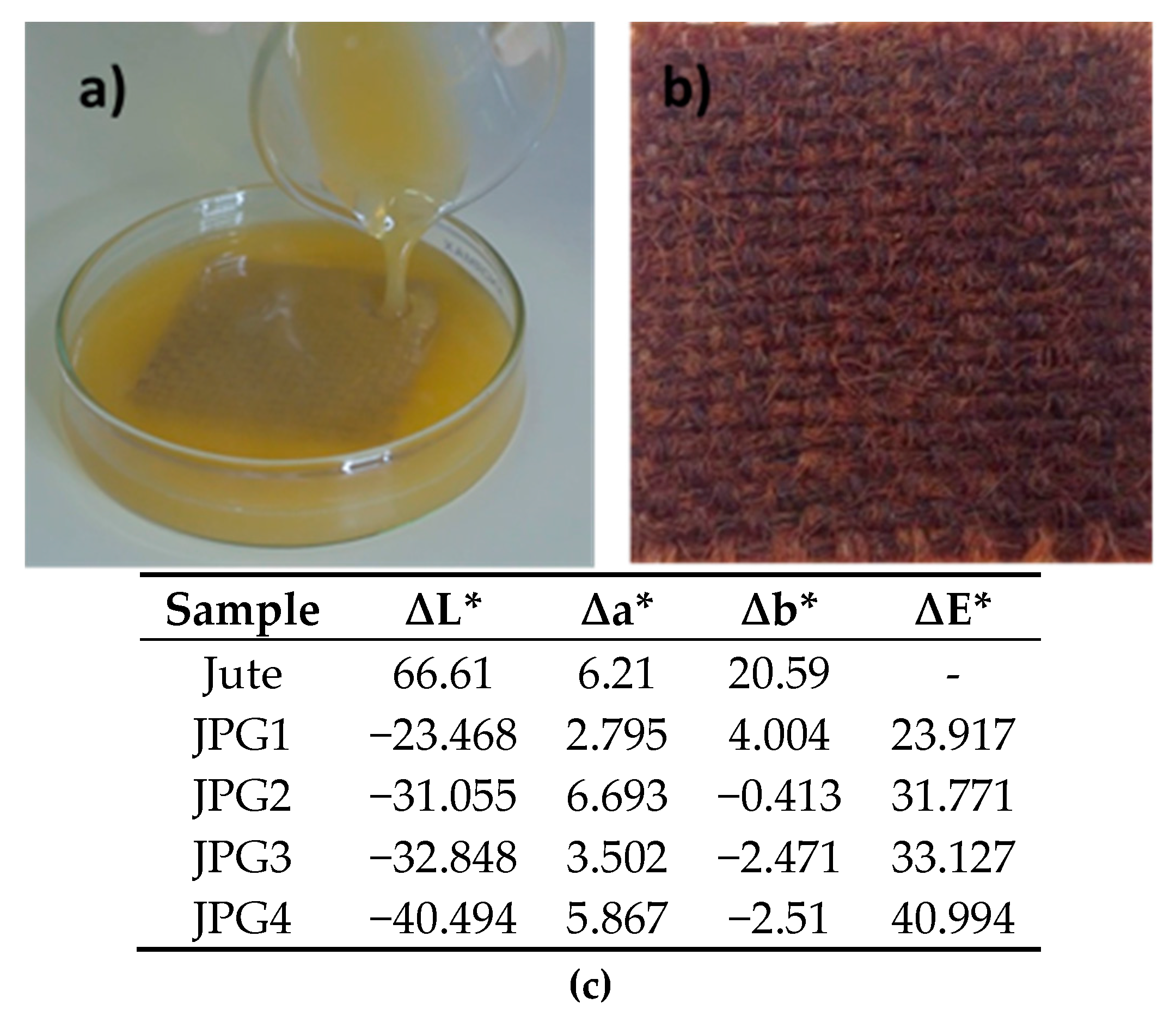
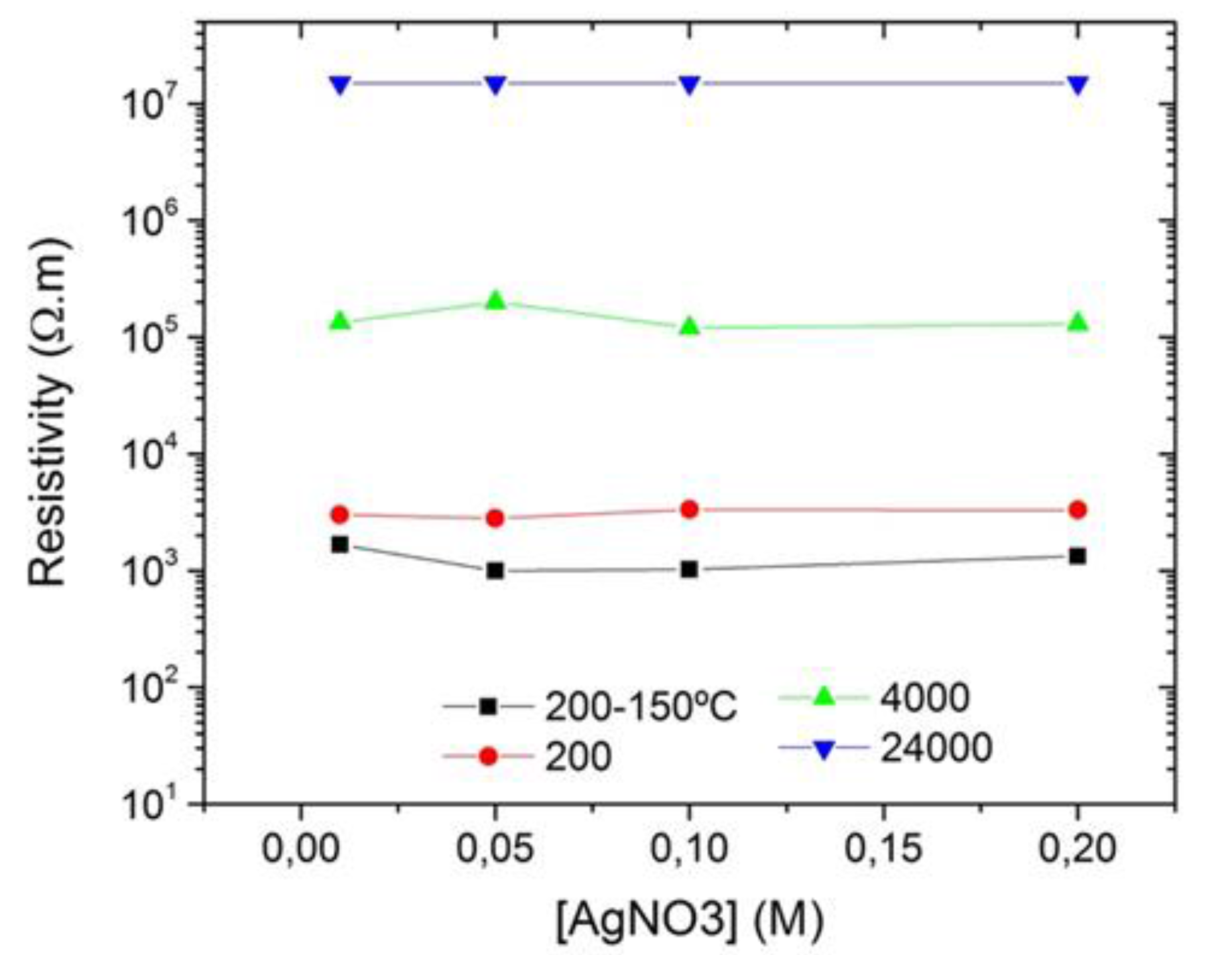
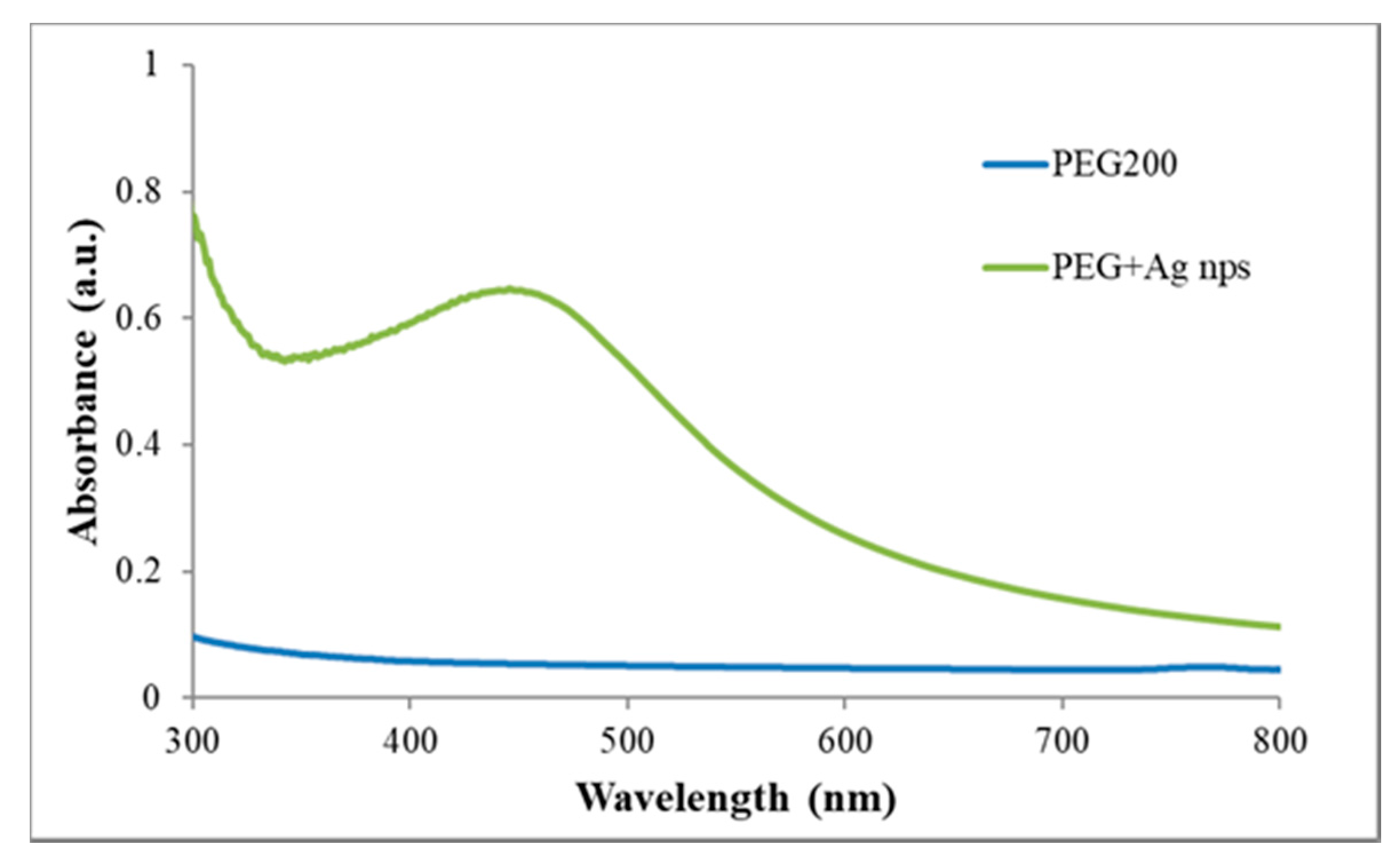
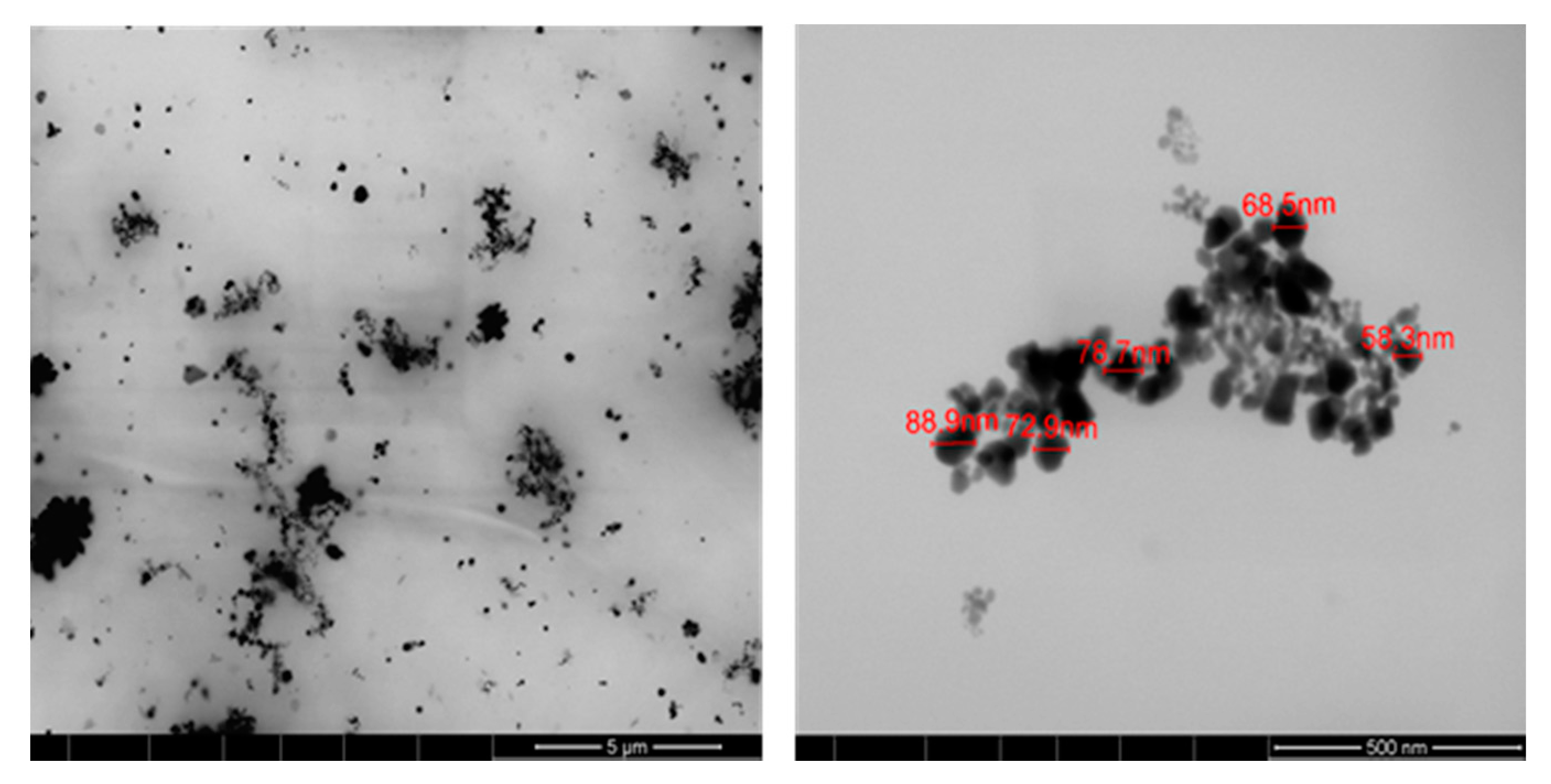
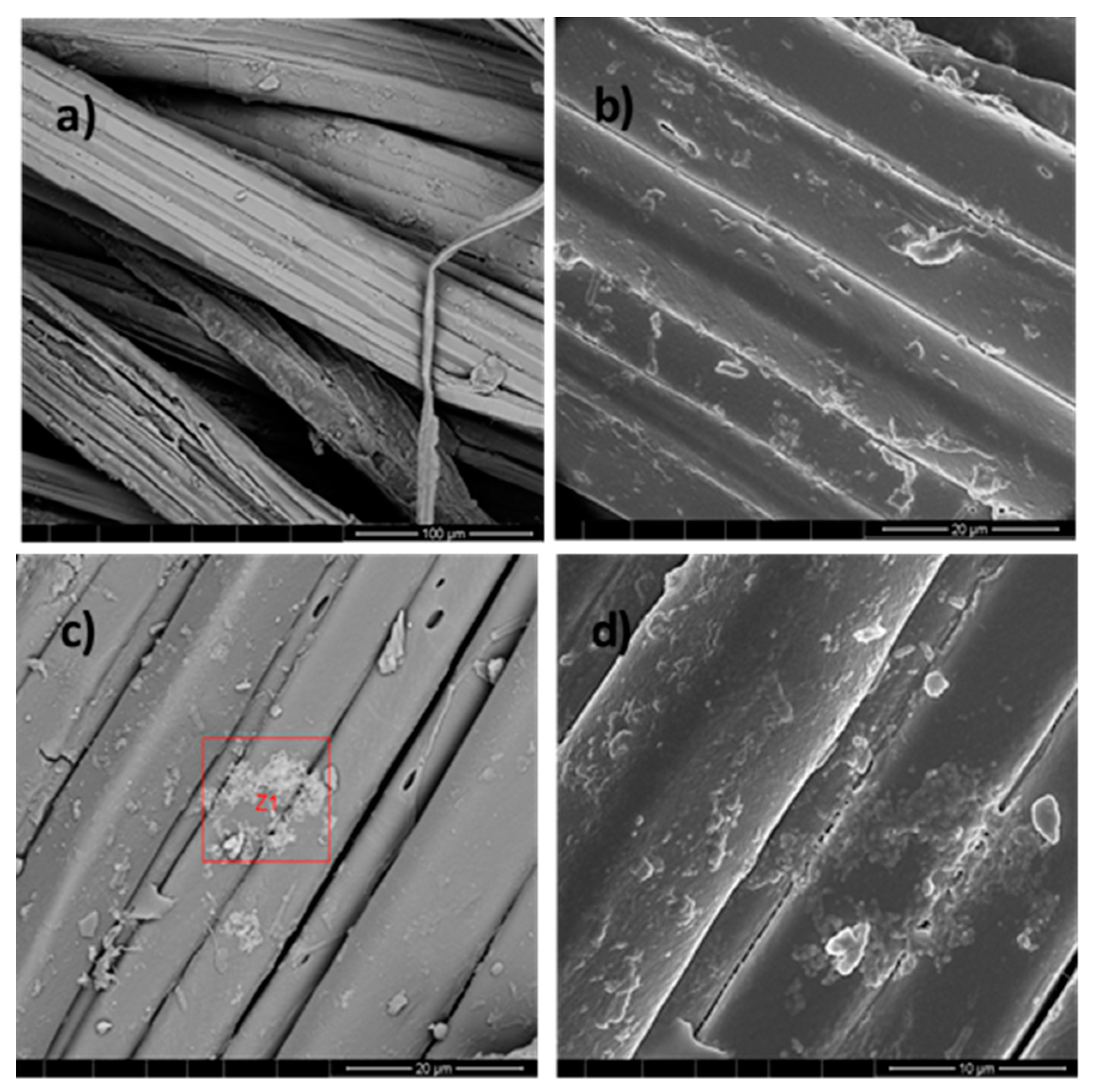
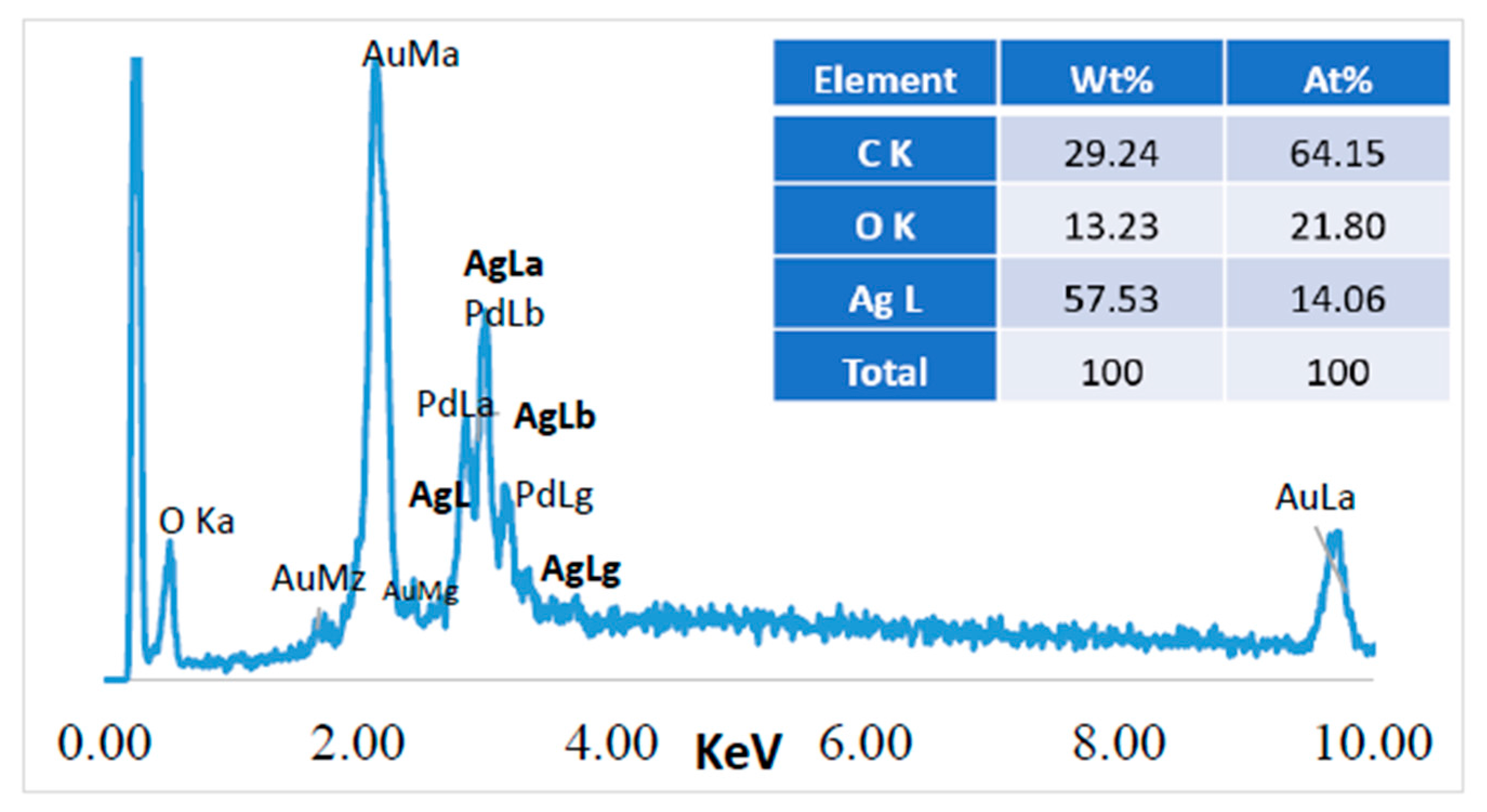
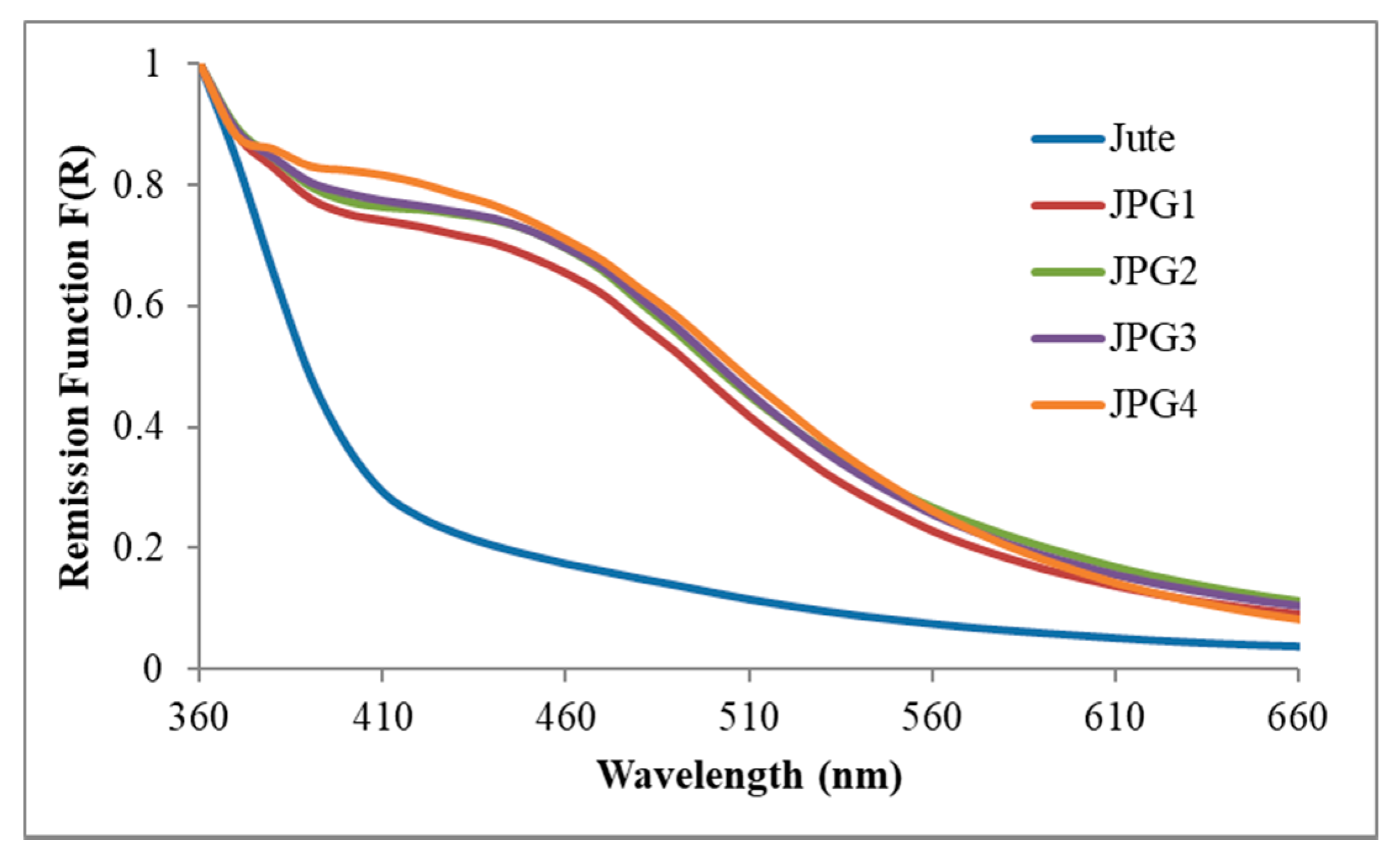
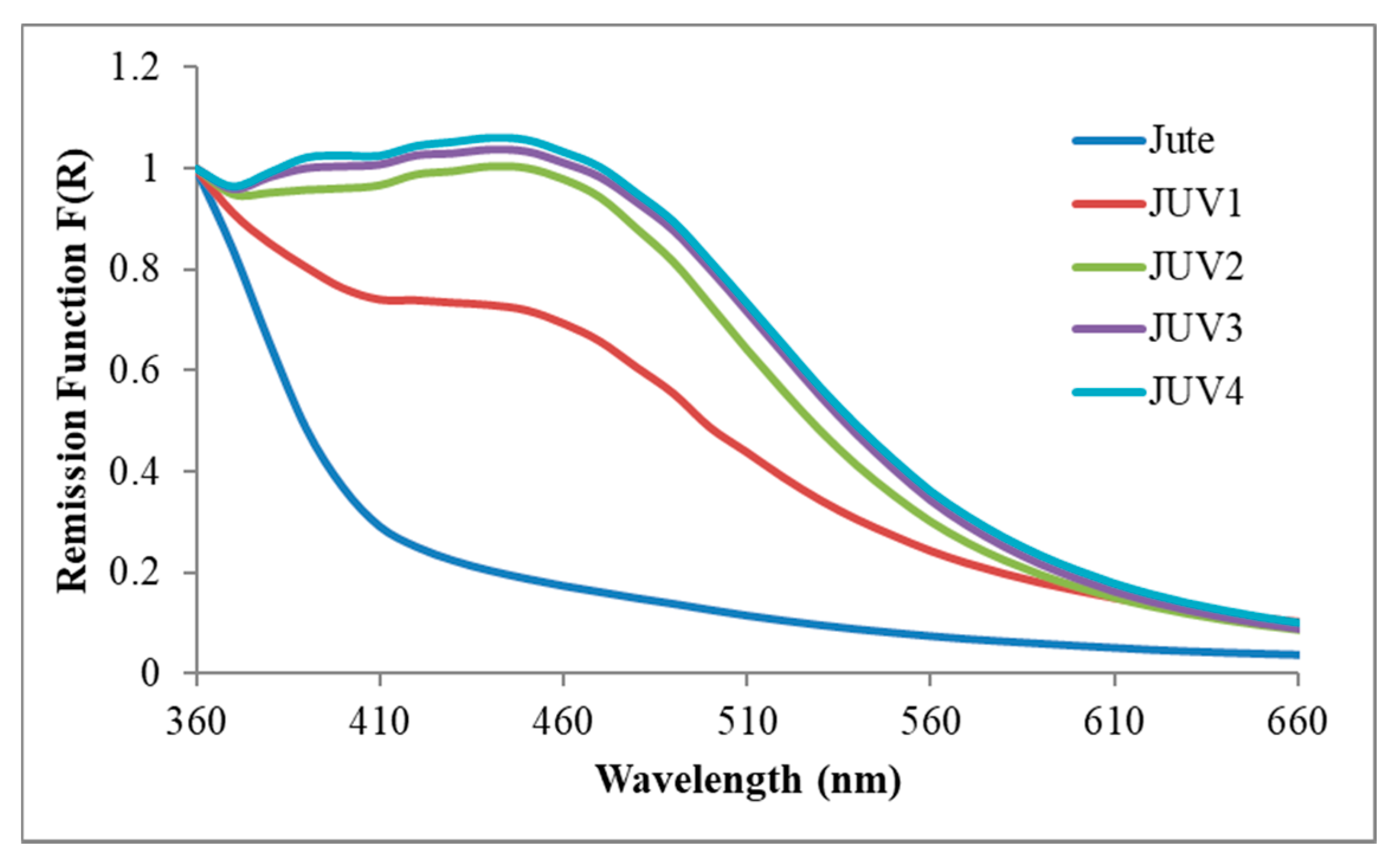
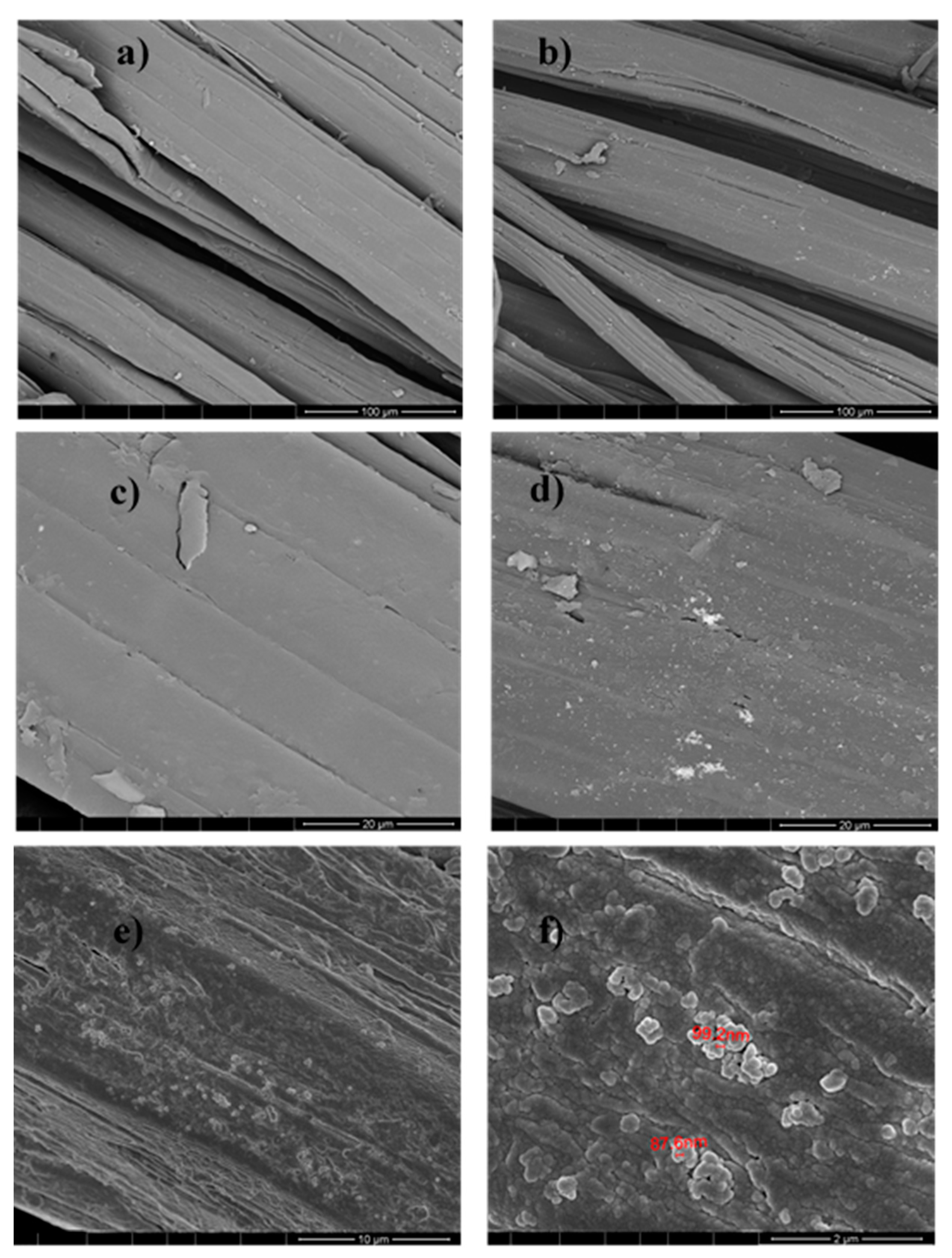
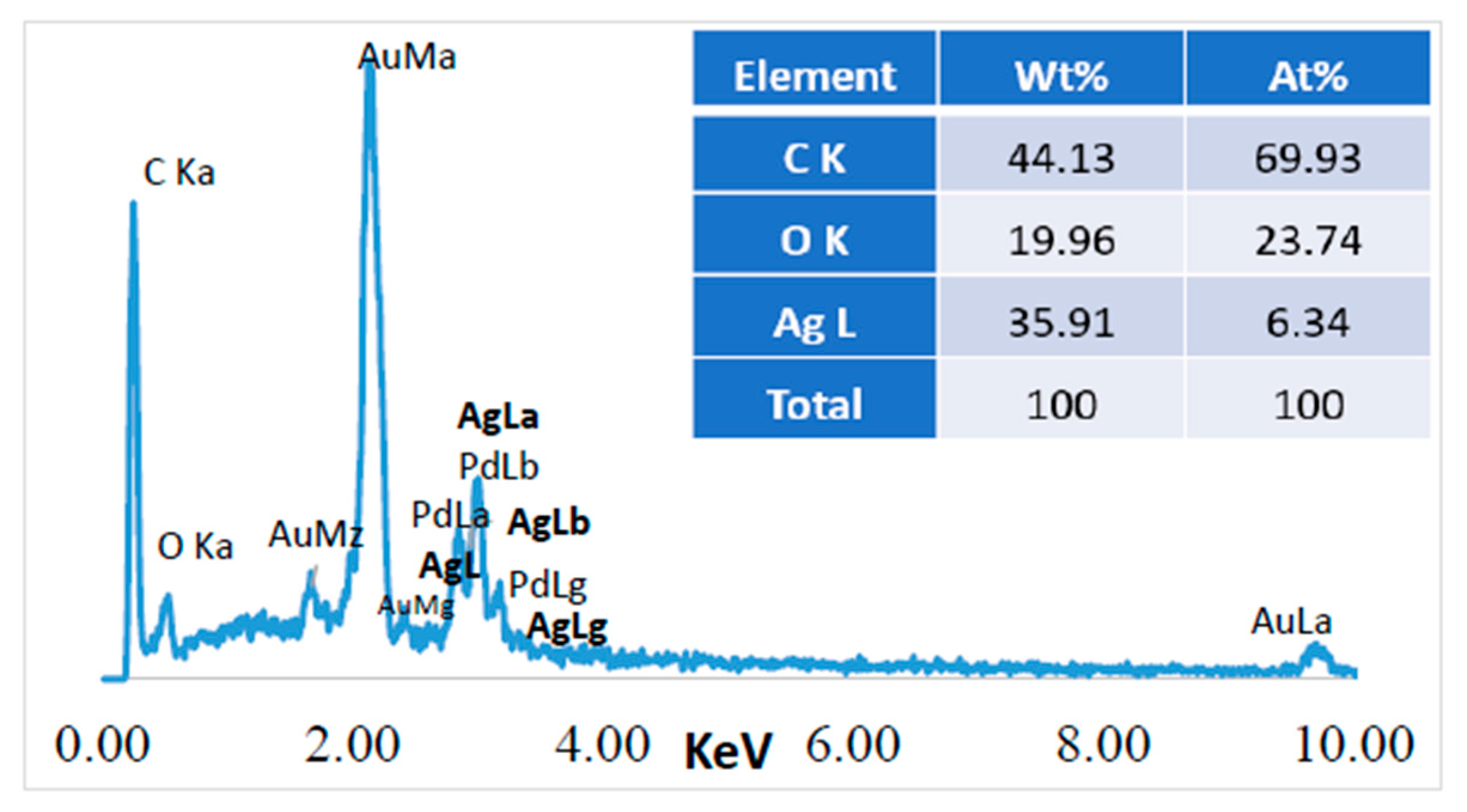

| Sample | [AgNO3] M | Immersion time | Irradiation time (each side) | Resistivity Ω·m |
|---|---|---|---|---|
| Jute | 0 | 0 | 0 | 1.5 × 107 |
| JUV1 | 0.01 | 2 h | 5 h | 1.0 × 107 |
| JUV2 | 0.05 | 2 h | 5 h | 6.7 × 105 |
| JUV3 | 0.1 | 2 h | 5 h | 1.7 × 105 |
| JUV4 | 0.2 | 2 h | 5 h | 6.7 × 104 |
| JUV5 | 0.01 | 24 h | 10 h | 3.3 × 106 |
| JUV6 | 0.05 | 24 h | 10 h | 6.7 × 105 |
| JUV7 | 0.1 | 24 h | 10 h | 1.7 × 105 |
| JUV8 | 0.2 | 24 h | 10 h | 5.0 × 104 |
| Sample | [AgNO3] M | PEG molecular weight | Impregnation time | Sintering process | Resistivity Ω·m |
|---|---|---|---|---|---|
| Jute | 0 | 0 | 0 | - | 1.50 × 107 |
| JPG1 | 0.01 | 200 | 24 h | 150 °C/2 h | 1.67 × 103 |
| JPG2 | 0.05 | 200 | 24 h | 150 °C/2 h | 1.00 × 103 |
| JPG3 | 0.1 | 200 | 24 h | 150 °C/2 h | 1.02 × 103 |
| JPG4 | 0.2 | 200 | 24 h | 150 °C/2 h | 1.33 × 103 |
| JPG5 | 0.01 | 200 | 24 h | - | 3.00 × 103 |
| JPG6 | 0.05 | 200 | 24 h | - | 2.80 × 103 |
| JPG7 | 0.1 | 200 | 24 h | - | 3.33 × 103 |
| JPG8 | 0.2 | 200 | 24 h | - | 3.30 × 103 |
| JPG9 | 0.01 | 4000 | 24 h | - | 1.33 × 105 |
| JPG10 | 0.05 | 4000 | 24 h | - | 2.00 × 105 |
| JPG11 | 0.1 | 4000 | 24 h | - | 1.20 × 105 |
| JPG12 | 0.2 | 4000 | 24 h | - | 1.30 × 105 |
| JPG13 | 0.01 | 24,000 | 24 h | - | 1.50 × 107 |
| JPG14 | 0.05 | 24,000 | 24 h | - | 1.50 × 107 |
| JPG15 | 0.1 | 24,000 | 24 h | - | 1.50 × 107 |
| JPG16 | 0.2 | 24,000 | 24 h | - | 1.50 × 107 |
© 2018 by the authors. Licensee MDPI, Basel, Switzerland. This article is an open access article distributed under the terms and conditions of the Creative Commons Attribution (CC BY) license (http://creativecommons.org/licenses/by/4.0/).
Share and Cite
Ferreira, D.P.; Ferreira, A.; Fangueiro, R. Searching for Natural Conductive Fibrous Structures via a Green Sustainable Approach Based on Jute Fibers and Silver Nanoparticles. Polymers 2018, 10, 63. https://doi.org/10.3390/polym10010063
Ferreira DP, Ferreira A, Fangueiro R. Searching for Natural Conductive Fibrous Structures via a Green Sustainable Approach Based on Jute Fibers and Silver Nanoparticles. Polymers. 2018; 10(1):63. https://doi.org/10.3390/polym10010063
Chicago/Turabian StyleFerreira, Diana P., Armando Ferreira, and Raul Fangueiro. 2018. "Searching for Natural Conductive Fibrous Structures via a Green Sustainable Approach Based on Jute Fibers and Silver Nanoparticles" Polymers 10, no. 1: 63. https://doi.org/10.3390/polym10010063








